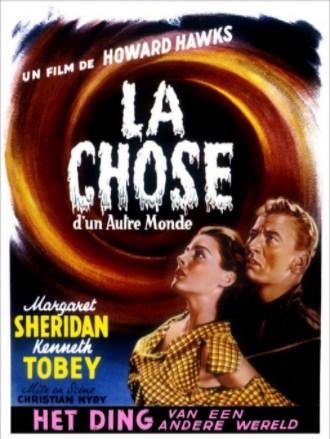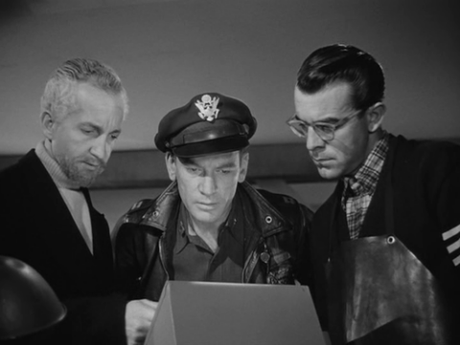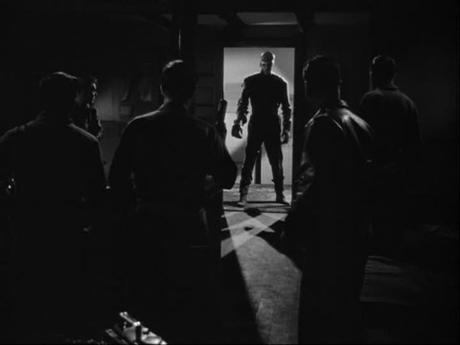
I bring you a warning: Everyone of you listening to my voice, tell the world, tell this to everybody wherever they are. Watch the skies. Everywhere. Keep looking. Keep watching the skies.
Those words quoted above are the last lines of Howard Hawks' The Thing from Another World (1951), a plea for caution and vigilance directed at an audience which had just spent an hour and a half having the pants scared off it and, beyond the world of the movies, was taking its first tentative steps into a (fairly) new decade where politics and science were moving ahead in a challenging fashion. As the Cold War tightened its icy grip on the world, Hollywood was serving up its own slice of chilling paranoia where the threat posed by unknown, malignant forces from without was never far away.
The wind is blowing cold in Anchorage, Alaska, intruding from time to time on the warm interiors of the USAF base. It's here that we first see Captain Hendry (Kenneth Tobey), playing cards with his men, easy in the company of those he knows well. And it's also here that news first filters through of a downed, unidentified aircraft. The scientists at a polar research station picked up images of it but they can't be sure what it is. So Hendry and his crew are sent north to see if they can assist in locating, identifying and dealing with whatever came down out on the ice. Measurements at the research station suggest it must have been something large that dropped from the skies, and sure enough that proves to be the case. To the amazement of those present, it would appear they have come upon a genuine flying saucer. However, their pleasure is to be short-lived as the efforts to melt the surrounding ice lead to the destruction of the craft. Yet all is not lost; a body remains intact, encased in a solid block of ice. Naturally, this one surviving element is brought back to the research station to be kept until it has been decided how to proceed, although a moment's carelessness sees events take a different and altogether more dangerous turn. That slab of polar ice contains something strong, potentially indestructible, and hungry.

The Thing from Another World sees Howard Hawks listed as producer while Christian Nyby gets the directing credit. According to most of those involved, that's how the job was divided up although the finished product clearly shows a considerable bit of input from Hawks - he said himself that he worked on the trademark overlapping dialogue that's to be found throughout the film. So, while this is clearly a Sci-Fi movie, and an iconic and influential one at that, I think it's fair to say it's a Hawks movie first and foremost. Even though I don't wish to drag this piece too deeply into comparison territory, the fact that this John W Campbell story was remade in 1982 by John Carpenter and has a markedly different feel should tell us that. The Hawks movie (as indeed could be said of the Carpenter film) is a product of its time, both politically and sociologically, and I suppose the same can be said of the filmmaker himself.
On the simplest level, a Hawks film is typically recognizable from its characteristic setting or circumstances - a tight, self-contained group bound together by their sense of professionalism, duty and mutual respect, and of course the affection that simultaneously gives rise to and grows out of their cohesion. Any Hawks film, and The Thing from Another World is no exception, is as much about the various bits of business and repartee that arise from the close interaction of the group. Ultimately, it's a celebration of social unity; people of significantly different backgrounds all (well, let's say largely) come together as a result of their shared sense of professionalism - and I feel that in the world of Hawks professionalism frequently equates to humanity - to meet adversity head-on. There's a particular kind of inclusiveness implicit here, something that's quite common in post-war cinema. This is what I mean when I speak of Hawks being a product of his time; I'm referring not to the Cold Warrior warning of external threats but the man who adheres to the concept of unity and communal strength. Above all else, I see that as the central message of The Thing from Another World, and that's why I consider it a Hawks movie as much as, or more than, a Sci-Fi movie. Look at the 1982 version of the story (and I'm not implying any criticism of it here) and its emphasis on suspicion, distrust and division and the point ought to be evident. Hawks, because of his own sensibilities and perhaps because of the era he lived in, could not have made The Thing from Another World in any other way.

Kenneth Tobey had been doing lots of bit parts and getting walk on roles before this opportunity came along. He was never to become a big star but, in among his other credits, he would star in another couple of entertaining Sci-Fi pictures, It Came from Beneath the Sea and The Beast from 20,000 Fathoms. His role here is of the square-jawed and decisive variety, and he handles that aspect very well. However, the heroes in Hawks' films generally need to be capable of carrying off the inevitable sharp humor too, and Tobey does have the required twinkle in his eyes when necessary. Some of this comes out of the by-play with the members of his flight crew but it's more obvious in the sparring with Margaret Sheridan. She was under contract to Hawks but her screen credits are limited and I don't remember seeing her in anything else, which I think is regrettable.
Seeing as this is mostly an ensemble piece, where the group is arguably as important a character as any individual, there aren't too many stand-out performances. Still, Douglas Spencer (who gets to deliver the lines at the top of this piece) gets a chance to shine as does the rather clinical Robert Cornthwaite along with Dewey Martin and John Dierkes. And of course, there is the Thing itself to consider - James Arness was a considerable presence in more conventional roles and his physicality is used to excellent effect in this film. He has no dialogue and is only glimpsed for long stretches, and when he does get more screen time he's still kept mainly in the shadows. Nevertheless, his job was to intimidate and threaten, and he does that very successfully.

In addition to those elements I already mentioned, there's so much more to enjoy about this production, not the least of which is the strong sense of claustrophobia achieved by Russell Harlan's moody photography, or the eerie scoring of Dimitri Tiomkin. With regard to the story, I haven't gone into the classic moral dilemma faced by so many movie scientists over how to approach new discoveries that also pose a major threat. The fact is this is a film demanding and deserving of a far longer and more detailed analysis than I'm going to try to deliver here. Instead, I've chosen to focus on a few of the auteurist principles which caught my attention, but you're welcome to raise any points you wish in the comments section. The Thing from Another World is a superior piece of classic Sci-Fi from a superior filmmaker, it's an easy recommendation.
